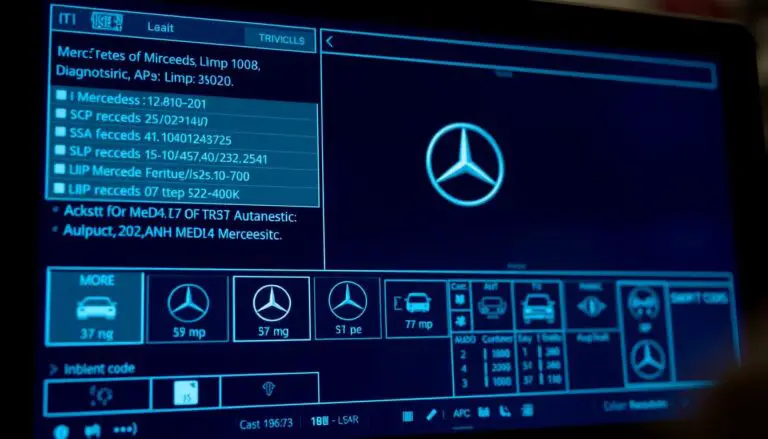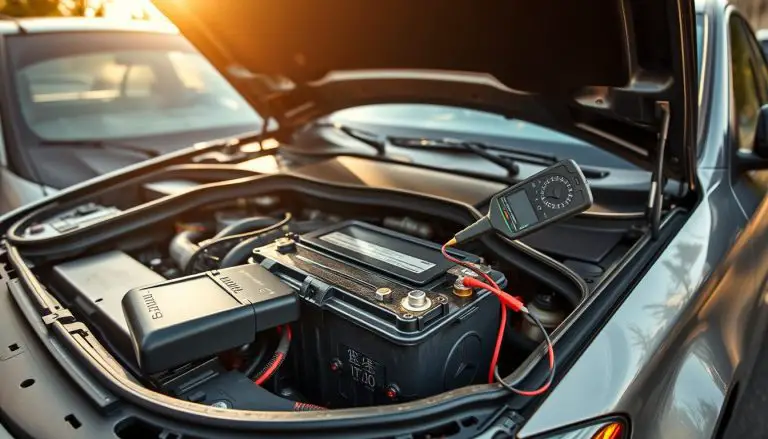The S-Class, notably the W222 model, epitomizes luxury sedans with its cutting-edge features and superior performance. Yet, its intricate design and advanced technology can sometimes lead to issues that detract from the driving experience.
Grasping the common issues plaguing the Mercedes W222 is essential for preserving its opulence and performance. This overview paves the way for delving into the prevalent problems and their solutions.
Key Takeaways
- Understanding the most common S-Class problems
- Identifying the causes of Mercedes W222 issues
- Exploring solutions to resolve these problems
- Tips for maintaining the S-Class’s performance
- Preventive measures to avoid future issues
Understanding the Mercedes W222 S-Class
The Mercedes-Benz W222 S-Class epitomizes the zenith of luxury and technological advancement within the automotive realm. Since its inception, this luxury sedan has served as a paragon for comfort, technological sophistication, and performance excellence.
Model Years and Variations
Spanning from 2013 to 2020, the Mercedes-Benz W222 S-Class underwent a significant facelift in 2017. It was offered in a variety of models, including the S 400, S 500, and the high-performance AMG variants, such as the S 63 and S 65. These models were designed to cater to diverse market segments, providing a spectrum of engine options and features.
Technology and Innovation Features
The W222 S-Class pioneered numerous automotive innovations, featuring cutting-edge technologies like the COMAND system, a semi-autonomous driving package, and the advanced Active Body Control (ABC) suspension system. Luxury features included premium interior materials, heated and ventilated seats, and a panoramic sunroof. It also introduced groundbreaking safety features, including adaptive LED lighting and a 360-degree camera system.

Known Vulnerability Points
Despite its groundbreaking advancements, the W222 S-Class encountered several known vulnerability points. These included issues with the air suspension, glitches in the COMAND system, and problems with the engine’s cooling system. Regular maintenance was imperative to address these concerns and ensure the vehicle’s longevity.
Common Mercedes Benz W222 Problems: An Overview
The Mercedes Benz W222 S-Class, celebrated for its opulence and dynamism, has encountered a plethora of common maladies across its model years. Grasping these issues is crucial for owners and prospective buyers to make strategic decisions regarding upkeep and rectification.
Frequency of Issues by Model Year
The incidence of malfunctions in the Mercedes W222 fluctuates with model year, with certain epochs experiencing a higher prevalence of problems. For example, the initial models (2014-2016) have been plagued by a plethora of electrical system anomalies. In contrast, the subsequent models (2017-2020) have encountered a greater frequency of suspension and steering malfunctions.
| Model Year | Common Issues | Frequency |
|---|---|---|
| 2014-2016 | Electrical System Malfunctions | High |
| 2017-2020 | Suspension and Steering Issues | Medium |
Most Reported Problem Categories
Mercedes W222 proprietors have cataloged a variety of afflictions, with electrical system malfunctions, suspension and steering anomalies, and engine-related troubles standing out as the most prevalent. These issues can incur substantial repair costs if not addressed expeditiously.
- Electrical System Malfunctions
- Suspension and Steering Issues
- Engine-Related Concerns
Warning Signs of Developing Issues
Recognizing the precursors to developing malfunctions is paramount to averting minor issues from escalating into major repairs. For the Mercedes W222, indicative signs include anomalous noises emanating from the suspension, dashboard warning lights signaling electrical system anomalies, and a decline in engine performance.

Diagnosing Electrical System Issues
Electrical system failures in the Mercedes W222 can manifest in various ways, from COMAND system malfunctions to battery drain issues. Diagnosing these problems requires a thorough understanding of the vehicle’s electrical architecture.
COMAND System Failures and Fixes
The COMAND system in the Mercedes W222 is a sophisticated infotainment system that can sometimes experience failures, including screen freezing and audio system malfunctions. Troubleshooting these issues involves checking for software updates and ensuring that the system’s hardware is functioning correctly.
Screen Freezing Solutions
Screen freezing in the COMAND system can be resolved by restarting the system or performing a software update. In some cases, a visit to a Mercedes-Benz service center may be necessary to diagnose and fix the issue.
Audio System Troubleshooting
For audio system issues, checking the speaker connections and ensuring that the audio settings are correctly configured can often resolve the problem. If the issue persists, consulting a professional may be necessary.
Battery Drain Problems
Battery drain is a common issue in the Mercedes W222, often caused by parasitic drain or faulty components. Identifying the source of the drain requires a systematic approach, using tools such as a multimeter to measure current draw. For more information on battery-related issues in Mercedes vehicles, you can visit this resource on hybrid battery problems.
Resolving Sensor Malfunctions
The Mercedes W222 relies on numerous sensors for its advanced safety and convenience features. When these sensors malfunction, it can lead to issues such as faulty collision avoidance or incorrect climate control. Diagnosing sensor malfunctions typically involves checking the sensor’s electrical connections and ensuring they are free from debris.
Fixing Suspension and Ride Quality Problems
Ride quality issues in the Mercedes W222 often stem from suspension-related malfunctions, which can be rectified with appropriate diagnostic and repair techniques.
The Mercedes W222’s suspension system is engineered to strike a balance between comfort and handling prowess. Yet, its complexity renders it susceptible to issues that can compromise the vehicle’s performance.
Air Suspension Failures
Air suspension failures in the Mercedes W222 frequently present as a rough ride, uneven vehicle height, or sagging on one side.
Compressor Replacement Guide
The process of replacing the air suspension compressor is relatively uncomplicated. It entails disconnecting the electrical connector, removing the mounting bolts, and carefully extracting the compressor from its housing.
Air Strut Diagnosis and Repair
Diagnosing air strut malfunctions requires an examination for leaks, inspection of the strut’s electrical connections, and monitoring its performance under diverse driving conditions.
ABC System Issues
The Active Body Control (ABC) system, a sophisticated suspension technology in the Mercedes W222, can experience issues that diminish ride quality and handling.
Common ABC system problems include hydraulic fluid leaks, sensor malfunctions, and control unit issues.
DIY Suspension Problem Diagnosis
Diagnosing suspension problems in your Mercedes W222 can be accomplished at home with basic tools and knowledge.
Begin by assessing the vehicle’s ride height and inspecting for uneven tire wear. Listen for unusual noises when traversing bumps, and scrutinize the suspension components for damage or wear.
| Suspension Component | Common Issues | Diagnostic Tips |
|---|---|---|
| Air Suspension Compressor | Failure to maintain air pressure, noisy operation | Listen for unusual noises, check for leaks |
| Air Struts | Leaks, failure to maintain ride height | Inspect for signs of wear, check electrical connections |
| ABC System | Hydraulic fluid leaks, sensor malfunctions | Check for signs of fluid leaks, monitor system performance |
Resolving Engine-Related Concerns
Addressing engine-related issues is paramount for the Mercedes W222’s optimal performance. Engine malfunctions, such as oil leaks and turbocharger failures, necessitate immediate attention to preserve the vehicle’s longevity.
Addressing Oil Leaks and Consumption
Mercedes W222 owners frequently encounter oil leaks and excessive oil consumption. These issues compromise the vehicle’s performance and can escalate to severe engine damage if neglected.
Common Leak Points
The Mercedes W222 is susceptible to oil leaks in areas like the valve cover gasket and oil pan gasket. Regular inspections are imperative for early detection. Prompt replacement of worn-out gaskets is essential to avert further damage.
Monitoring and Maintenance
Consistent oil level checks and monitoring oil consumption are crucial for early detection of potential problems. Adherence to the recommended maintenance schedule in the vehicle’s manual is vital to maintain the engine’s integrity.
Turbocharger Problems and Solutions
Turbocharger failure is a significant concern for Mercedes W222 owners. Symptoms include diminished engine performance and unusual noises. Regular maintenance, such as checking for oil leaks and ensuring proper lubrication, is vital to prevent turbocharger failure.
Cooling System Failure Prevention
The cooling system is essential for engine health. Preventive measures include regular coolant level checks, hose inspections for wear, and ensuring the radiator’s condition.
“A well-maintained cooling system is key to preventing engine overheating and damage.”
Proactive management of engine-related concerns ensures the Mercedes W222 continues to operate efficiently and smoothly.
Transmission and Drivetrain Troubleshooting
Diagnosing transmission and drivetrain faults in the Mercedes W222 necessitates a profound comprehension of its advanced engineering and the application of precise troubleshooting methodologies. The transmission and drivetrain are pivotal to the vehicle’s performance and comfort, thus, any issues must be addressed expeditiously.
9G-Tronic Transmission Repair Options
The 9G-Tronic transmission, a sophisticated component of the Mercedes W222, is renowned for its efficiency and performance. Despite its complexity, it can encounter problems. Common maladies include slipping, delayed shifting, and failure to engage gears properly. Repair options frequently entail updating the transmission software, replacing faulty solenoids, or, in more severe instances, replacing the transmission itself. For comprehensive repair guides and troubleshooting, consulting resources such as Automotive Simple can offer invaluable insights.
4MATIC System Problem Resolution
The 4MATIC system, integral to the Mercedes W222’s traction and stability, can, conversely, be a source of problems. Symptoms such as unusual noises, vibrations, or dashboard warning lights can indicate a malfunction. Troubleshooting the 4MATIC system necessitates fluid level checks, leak inspections, and potentially, the replacement of worn or damaged components. In some instances, a software update may rectify the issue.
Improving Shift Quality
Shift quality is a critical aspect of the driving experience in the Mercedes W222. Factors influencing shift quality include the condition of the transmission fluid, the state of the transmission’s electronic controls, and the overall health of the drivetrain. Regular maintenance, such as fluid changes and software updates, can significantly enhance shift quality. Addressing any mechanical issues with the drivetrain’s components is also crucial for maintaining smooth and responsive shifting.
| Issue | Symptoms | Potential Solutions |
|---|---|---|
| 9G-Tronic Transmission Problems | Slipping, delayed shifting | Software update, solenoid replacement |
| 4MATIC System Issues | Unusual noises, vibrations | Fluid level check, component replacement |
| Poor Shift Quality | Harsh or delayed shifting | Transmission fluid change, software update |
Fixing Interior and Comfort System Failures
The Mercedes W222’s interior, a paragon of luxury, occasionally encounters malfunctions. These problems can severely diminish the driving experience. This section delves into prevalent issues and their resolutions.
Seat Function Repair Guide
The seats in your Mercedes W222 transcend mere comfort, embodying the vehicle’s luxury essence. Seat malfunctions, from adjustment failures to heating and cooling issues, can be distressing.
- Verify the fuse associated with the seat functions.
- Examine the wiring and connectors for any damage.
- Reset the seat control module if feasible.
For intricate problems, professional intervention may be imperative to identify and rectify or replace defective parts.
Climate Control System Troubleshooting
The climate control system is pivotal for cabin comfort. Issues like temperature inconsistencies or system failure can be vexing.
- Review the climate control settings to ensure it’s not in automatic mode causing the problem.
- Inspect and replace the cabin air filter if it’s soiled.
- Verify if there are any software updates for the climate control system.
If these measures fail to resolve the issue, a visit to a Mercedes-Benz service center is advisable to uncover underlying problems.
Eliminating Rattles and Interior Quality Issues
Rattles and other interior quality issues can diminish the Mercedes W222’s luxurious ambiance. Common culprits include loose trim, dashboard components, or other interior elements.
- Examine the interior trim and dashboard for any loose parts.
- Tighten any loose screws or clips.
- Utilize a noise diagnostic kit to pinpoint rattle sources.
Timely resolution of these issues is crucial for preserving the vehicle’s interior quality and comfort.
DIY Diagnostics and Professional Repair Guidelines
For Mercedes W222 owners, the acquisition of DIY diagnostics proficiency is a strategic advantage, enabling the identification of malfunctions prior to their escalation. This capability not only streamlines the diagnostic process but also mitigates the financial burden associated with repeated repair endeavors.
Using OBD Scanners for W222 Diagnostics
An OBD (On-Board Diagnostics) scanner emerges as a pivotal tool for DIY diagnostics, facilitating direct connection to the Mercedes W222’s OBD port to extract diagnostic trouble codes (DTCs). These codes serve as indicators of specific malfunctions within the vehicle’s systems. For the W222, the utilization of an advanced OBD scanner, one that accommodates Mercedes-Benz specific protocols, is imperative for precise diagnostics.
In the selection of an OBD scanner, prioritize devices that offer comprehensive system coverage, encompassing engine, transmission, and suspension. Generic OBD-II scanners, alongside Mercedes-Benz specific tools such as the Mercedes-Benz diagnostic software, are recommended for their extensive diagnostic capabilities.
| OBD Scanner Type | Compatibility | Diagnostic Depth |
|---|---|---|
| Generic OBD-II | Most vehicles, including Mercedes W222 | Basic engine and emissions diagnostics |
| Mercedes-Benz Specific | Mercedes-Benz vehicles, including W222 | Advanced diagnostics for engine, transmission, suspension, and more |
When to Seek Professional Mercedes Service
While DIY diagnostics are invaluable, there are instances where professional Mercedes service is indispensable. Complex malfunctions necessitating specialized tools or expertise, such as those affecting the vehicle’s advanced driver assistance systems (ADAS) or sophisticated engine management systems, are best addressed by certified technicians.
Further, if DIY diagnostics uncover a significant issue, it is often more economical in the long term to entrust a professional mechanic with the repairs. They can guarantee that the problem is resolved correctly and safely, thus averting potential complications stemming from improper repairs.
Cost-Saving Maintenance Strategies
Adherence to the recommended maintenance schedule is paramount in preventing costly repairs. For the Mercedes W222, regular maintenance can preemptively identify potential issues. Simple yet crucial actions, such as routine oil changes, tire rotations, and brake pad replacements, can significantly prolong your vehicle’s lifespan.
Equally important is the maintenance of your vehicle’s software. Updates frequently enhance performance, fuel efficiency, and address known issues. By consistently updating your vehicle’s software, you can circumvent many of the common problems associated with the W222.
Conclusion: Maintaining Your W222 for Longevity
Ensuring the longevity of your Mercedes W222 necessitates a commitment to regular maintenance. Acquaintance with prevalent issues and their resolutions empowers proactive measures to avert malfunctions and uphold your luxury sedan’s performance standards.
Adherence to Mercedes W222 maintenance protocols entails diligent inspections of the electrical, suspension, and engine systems. Prompt repairs and upkeep can markedly elevate your vehicle’s longevity, ensuring it remains in peak condition.
Adopting the strategies discussed in this article enables you to tackle common problems and forestall the escalation of more critical issues. Optimal Mercedes Benz care integrates routine maintenance, timely repairs, and a comprehensive grasp of your vehicle’s requirements.
By dedicating attention to your W222’s upkeep, you can savor a dependable and opulent driving experience for extended periods.
FAQ
What are the most common problems with the Mercedes W222 S-Class?
The Mercedes W222 S-Class frequently encounters malfunctions within its electrical system, suspension, and engine. Predominant issues include failures of the COMAND system, malfunctions of the air suspension, and oil leaks. These problems can significantly impact the vehicle’s performance and reliability.
How do I diagnose electrical system issues in my Mercedes W222?
To diagnose electrical system issues in your Mercedes W222, it is advisable to inspect the COMAND system, battery drain, and sensor malfunctions. Utilizing an OBD scanner can further aid in identifying any trouble codes, thus facilitating a comprehensive diagnosis.
What are the warning signs of developing suspension issues in my Mercedes W222?
Indicators of suspension problems in your Mercedes W222 include unusual noises, vibrations, or an uneven ride quality. Should you encounter these symptoms, it is imperative to have your suspension professionally evaluated to prevent further deterioration.
Can I repair transmission issues in my Mercedes W222 myself?
While some transmission issues may be addressed DIY, it is advisable to seek professional assistance for more complex problems, such as 9G-Tronic transmission repair. Simple maintenance tasks, like fluid checks and filter replacements, can be safely performed at home.
How can I improve the shift quality of my Mercedes W222’s transmission?
To enhance the shift quality of your Mercedes W222’s transmission, regular maintenance is essential. This includes fluid checks and filter replacements. Updating the transmission software or replacing worn-out components can also contribute to improved performance.
What are the benefits of using an OBD scanner for Mercedes W222 diagnostics?
Utilizing an OBD scanner offers several advantages, including the ability to identify trouble codes, monitor engine performance, and diagnose electrical system issues. This approach can significantly reduce repair costs and time by addressing problems promptly.
How often should I perform maintenance on my Mercedes W222 to prevent common problems?
Regular maintenance is critical in preventing common issues in your Mercedes W222. Adherence to the manufacturer’s recommended schedule for oil changes, tire rotations, and other maintenance tasks is paramount to ensuring optimal performance and longevity.
Can I fix interior and comfort system failures in my Mercedes W222 myself?
DIY repair of certain interior and comfort system failures, such as seat function repair or climate control system troubleshooting, is feasible. Yet, more intricate problems may necessitate professional intervention to ensure proper resolution.


